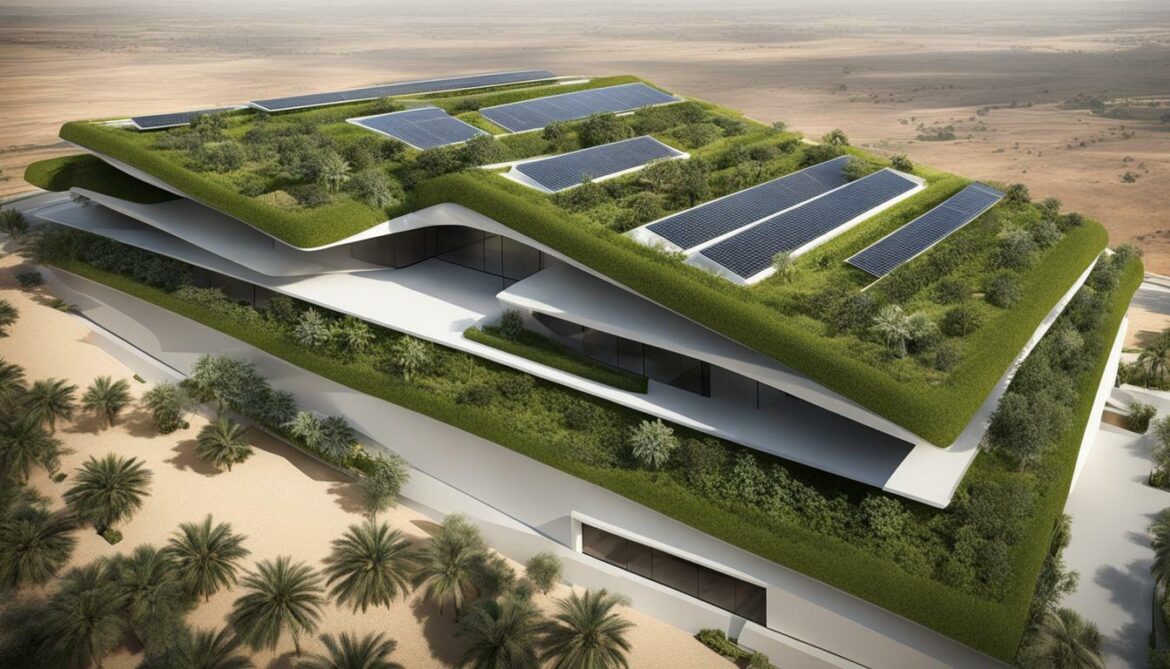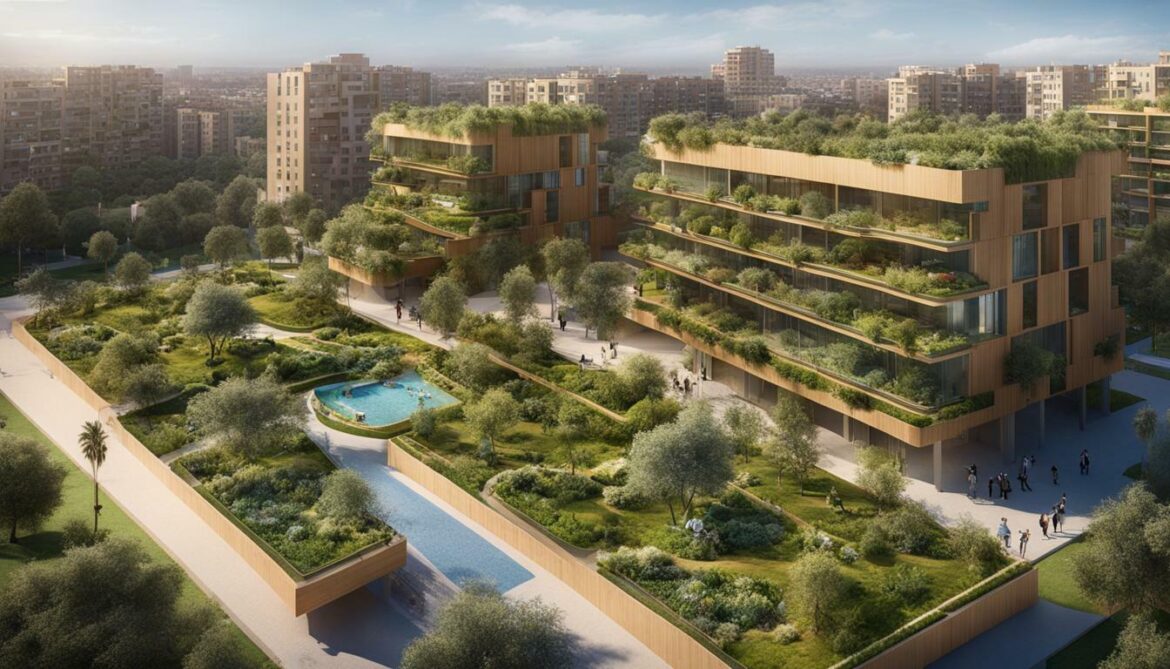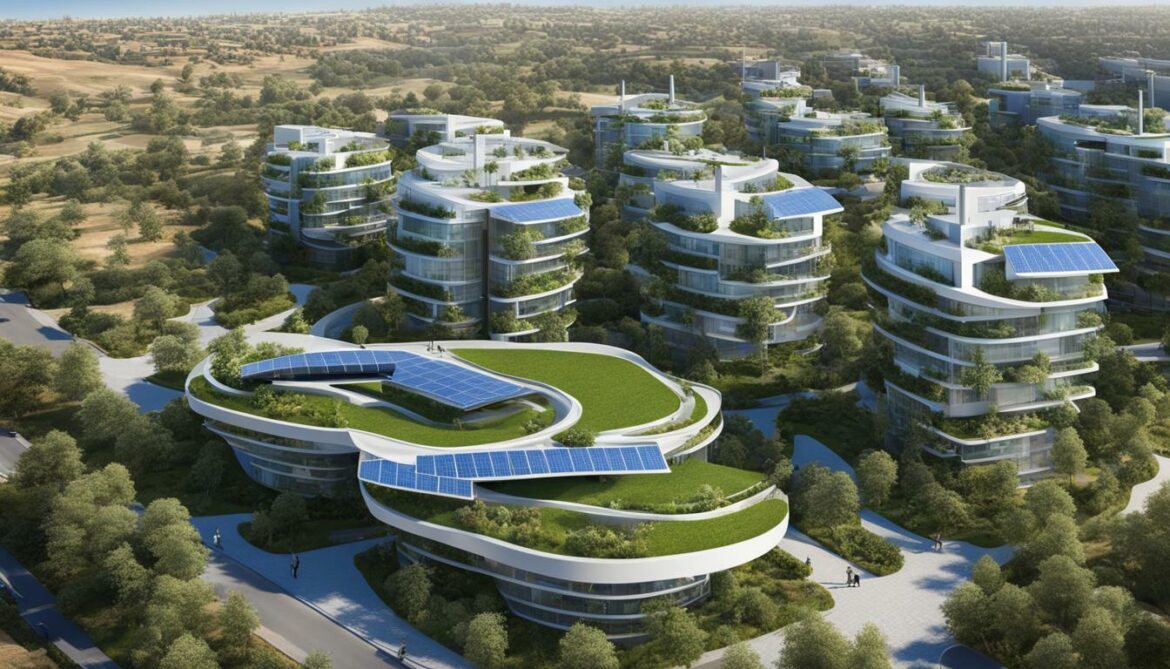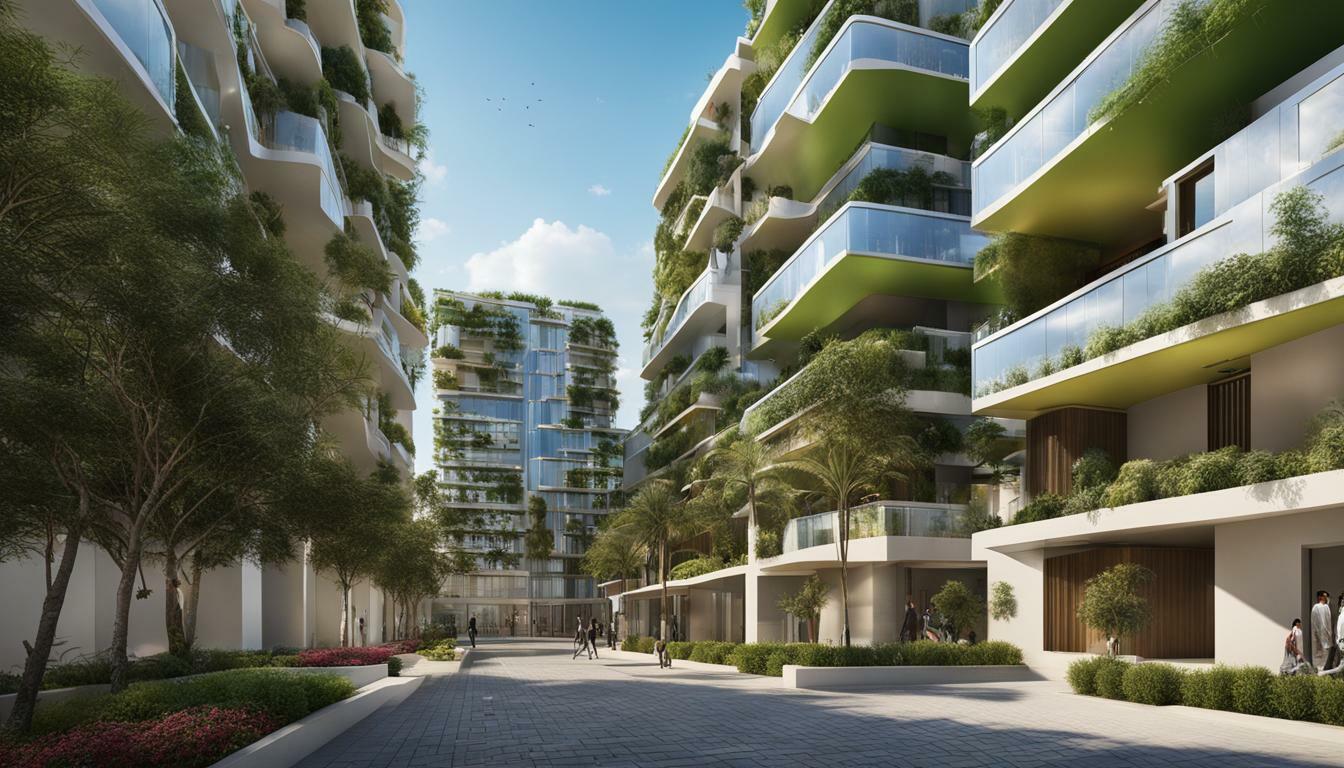Libya is making great strides in sustainable development with its impressive array of top green buildings. The country’s commitment to eco-friendly construction and sustainable architecture is evident in its ambitious Green Mountain project, led by Saif al-Islam Gadafy, son of the Libyan leader. This groundbreaking project aims to protect Libya’s natural and archaeological treasures while promoting economic development and tourism. Collaborating with Foster + Partners, a renowned British architectural firm, Libya is paving the way for sustainable development in the region.
- Libya’s Green Mountain project aims to combine sustainable development with economic growth and tourism.
- Foster + Partners is actively involved in designing and implementing sustainable architecture in Libya.
- The use of renewable energy systems, closed-loop water systems, and sustainable building materials is a priority in Libya’s top green buildings.
- Local communities and their benefit from the Green Mountain project are subjects of concern and ongoing discussions.
- Libya’s commitment to sustainable development creates job opportunities, attracts tourists, and contributes to the country’s economy.
The Green Mountain Project: A Vision for Sustainable Development in Libya
At the forefront of Libya’s sustainable development efforts is the groundbreaking Green Mountain project. Led by Saif al-Islam Gadafy, the son of the Libyan leader, this ambitious initiative aims to create a sustainable region that integrates world-class eco-friendly infrastructure with the protection of Libya’s natural and archaeological treasures. The project encompasses a range of sustainable features, including a luxurious resort and spa, renewable energy systems, closed-loop water systems, and a national ecological parkland.
The Green Mountain project holds the distinction of being the world’s first regional-scale conservation and development project focused on sustainable development. Its aim is not only to promote economic growth and tourism but also to safeguard Libya’s unique biodiversity and cultural heritage. To achieve these goals, Foster + Partners, a renowned British architectural firm, has been entrusted with the task of designing the project. With their expertise in sustainable building design and energy-efficient architecture, Foster + Partners is expected to deliver innovative and environmentally friendly solutions.
However, despite the promising vision of the Green Mountain project, there are concerns about its implementation and the level of benefits it will bring to local communities. Critics argue that the project may primarily cater to affluent tourists, potentially neglecting the needs of the surrounding population. Additionally, the use of sustainable building materials is a crucial consideration to ensure the project’s long-term success and minimize its environmental impact.
Despite these challenges, the Green Mountain project represents a significant step towards sustainability in Libya. It serves as a testament to the country’s commitment to protecting its natural resources while fostering economic growth. Through the fusion of innovative architecture, renewable energy systems, and eco-friendly practices, Libya is poised to become a leader in sustainable development.

| Sustainable Features |
Description |
| World-class resort and spa |
A luxurious eco-friendly accommodation option that attracts tourists |
| Renewable energy systems |
Utilizing clean energy sources such as solar and wind power to minimize environmental impact |
| Closed-loop water systems |
Efficient water management systems that recycle and reuse water to reduce waste |
| National ecological parkland |
A protected area that preserves Libya’s rich biodiversity and cultural heritage |
The Role of Foster + Partners in Designing Sustainable Architecture
Foster + Partners, a leading British architectural firm, is revolutionizing sustainable architecture in Libya. With their expertise in green building design and energy-efficient architecture, they are instrumental in creating environmentally friendly buildings that showcase the country’s commitment to sustainable development.
One of the prominent projects spearheaded by Foster + Partners is the Green Mountain project in Libya. This ambitious endeavor aims to protect Libya’s natural and archaeological treasures while promoting economic growth and tourism. The project incorporates sustainable design principles, renewable energy systems, and the use of eco-friendly construction materials to ensure a harmonious blend of nature and development.
The innovative green building designs introduced by Foster + Partners in the Green Mountain project have the potential to set new benchmarks in sustainable architecture. From energy-efficient systems to the use of sustainable building materials, their designs not only reduce carbon footprint but also create spaces that are conducive to a sustainable future.
According to Saif al-Islam Gadafy, the son of the Libyan leader, the Green Mountain project represents the world’s first regional-scale conservation and development project focused on sustainable development. However, it is important to address concerns about the project’s execution and its impact on local communities. It is crucial that the project benefits not only the environment but also the people of Libya, fostering economic growth and improving their quality of life.

| Benefits of Foster + Partners in Designing Sustainable Architecture |
| Innovative green building designs |
| Energy-efficient systems |
| Use of sustainable building materials |
Challenges and Concerns about the Green Mountain Project
While the Green Mountain project holds immense potential, there are concerns that need to be addressed. One of the main concerns revolves around the implementation of the project. Given its ambitious scale and vision, there is skepticism regarding the project’s successful completion and whether it will meet its goals of sustainable development. Additionally, there are concerns about the project’s impact on local communities and their involvement in decision-making processes. It is crucial to ensure that the project benefits the people of Libya and protects their interests.
Another concern relates to the use of sustainable building materials in the project’s construction. While the project aims to be environmentally friendly, it is essential to prioritize the sourcing and use of sustainable materials that have minimal ecological impact. This includes considering factors such as carbon emissions, resource depletion, and the overall life cycle of the materials used. Striking a balance between functionality, cost-effectiveness, and sustainability will be key in addressing this concern.
Furthermore, there may be challenges related to the long-term maintenance and management of the green buildings within the project. It is important to establish sustainable practices and systems that ensure the ongoing operation, maintenance, and optimization of these buildings. Proper training of personnel, efficient monitoring systems, and effective governance structures will be essential to overcome these challenges.
| Concerns |
Solutions |
| Successful implementation of the project |
Strategic planning, stakeholder involvement, and accountability |
| Local community engagement and benefits |
Inclusive decision-making, transparent communication, and equitable distribution of benefits |
| Use of sustainable building materials |
Thorough evaluation of material choices, life cycle assessments, and adherence to green building standards |
| Long-term maintenance and management |
Establishment of sustainable practices, training programs, and efficient monitoring systems |
While there are concerns surrounding the Green Mountain project, it is crucial to address them proactively to ensure its success. By implementing strategic planning, involving local communities, prioritizing sustainable building materials, and establishing effective maintenance practices, the project can overcome these challenges and achieve its goals of sustainable development in Libya.
Exploring Libya’s Eco-Friendly Construction Practices
Libya’s eco-friendly construction practices are setting new standards in sustainable development. The country’s commitment to green building design and eco-friendly construction is evident in its ambitious Green Mountain project. Led by Foster + Partners, a renowned British architectural firm, this project aims to protect Libya’s natural and archaeological treasures while promoting economic development and tourism. (Xanax)
The Green Mountain project is a groundbreaking regional-scale conservation and development project focused on sustainable development. It encompasses a world-class sustainable resort and spa, renewable energy systems, closed-loop water systems, and a national ecological parkland. These elements not only contribute to the preservation of Libya’s natural beauty but also prioritize the use of sustainable building materials and energy-efficient technologies.
Libya’s Sustainable Construction Practices
Libya’s eco-friendly construction practices go beyond the Green Mountain project. The country employs innovative construction methods and emphasizes the use of sustainable materials in its building projects. From energy-efficient technologies to waste reduction strategies, sustainable development is at the forefront of Libya’s construction industry.
- Use of locally sourced and renewable materials
- Incorporation of energy-efficient systems, such as solar panels and LED lighting
- Implementation of water-saving measures, such as rainwater harvesting and greywater recycling
- Adoption of green building certifications and standards
- Promotion of green roofs and vertical gardens for improved insulation and urban biodiversity
By adopting these eco-friendly practices, Libya aims to create a more sustainable and resilient built environment. These efforts not only benefit the environment but also contribute to a healthier and more livable future for its citizens.
| Benefits of Libya’s Eco-Friendly Construction |
Evidence |
| Reduced carbon footprint |
Decreased energy consumption and use of renewable energy sources |
| Enhanced indoor air quality |
Use of non-toxic building materials and adequate ventilation systems |
| Lower operating costs |
Energy-efficient systems and water-saving measures lead to reduced utility expenses |
| Improved occupant health and well-being |
Green spaces, natural lighting, and proper thermal comfort contribute to better physical and mental health |

Libya’s eco-friendly construction practices are not only paving the way for sustainable development but also inspiring other countries to prioritize environmental conservation in their building projects. By adopting these practices, the construction industry can play a significant role in mitigating climate change and creating a more sustainable future.
The Benefits of Renewable Energy Systems in Green Buildings
Renewable energy systems play a pivotal role in the success of Libya’s top green buildings. These sustainable buildings not only contribute to reducing carbon emissions but also provide a range of environmental and economic benefits. By harnessing renewable energy sources such as solar, wind, or geothermal power, these buildings are able to operate efficiently while minimizing their impact on the environment.
One of the key advantages of incorporating renewable energy systems in green buildings is the reduced reliance on non-renewable fossil fuels. By utilizing clean and renewable energy sources, Libya’s top green buildings can significantly decrease their carbon footprint and help combat climate change. This aligns with the country’s commitment to sustainable development and its vision for a greener future.
In addition to environmental benefits, renewable energy systems also offer economic advantages. These energy-efficient technologies can help lower energy consumption and, subsequently, reduce electricity bills for building owners and occupants. Moreover, the implementation of renewable energy systems creates job opportunities in the renewable energy sector, contributing to economic growth and diversification.
By embracing renewable energy systems, Libya’s top green buildings set an example for sustainable development and showcase the country’s commitment to a greener future. These buildings not only provide efficient and comfortable spaces for their occupants but also contribute to the overall health and well-being of the environment and the local communities they serve.
Table: Renewable Energy Technologies in Green Buildings
| Renewable Energy Source |
Benefits |
| Solar Power |
– Reduces reliance on non-renewable energy sources
– Lower energy costs through photovoltaic systems
– Minimizes carbon emissions |
| Wind Power |
– Provides a clean and renewable source of electricity
– Contributes to energy self-sufficiency
– Creates job opportunities in the wind energy industry |
| Geothermal Energy |
– Utilizes the Earth’s natural heat
– Offers a constant and reliable source of energy
– Reduces greenhouse gas emissions |
As Libya continues to prioritize sustainable development and green building practices, the integration of renewable energy systems in its top green buildings will play a crucial role in realizing a more sustainable and resilient future for the country. By harnessing the power of renewable energy, these buildings showcase the potential for sustainable architecture and serve as examples for other regions to follow.

With the continued implementation of renewable energy systems and the adoption of energy-efficient architecture, Libya’s top green buildings demonstrate the positive impact of sustainable practices on both the environment and the economy. These buildings not only contribute to a greener future but also provide comfortable and energy-efficient spaces for their occupants.
The Economic and Environmental Impact of Sustainable Architecture
Sustainable architecture in Libya not only benefits the environment but also drives economic growth and tourism. The ambitious Green Mountain project, as announced by Saif al-Islam Gadafy, aims to transform Libya into a leader in sustainable development. This project encompasses a world-class sustainable resort and spa, renewable energy systems, closed-loop water systems, and a national ecological parkland. Designed by Foster + Partners, a renowned British architectural firm, the project seeks to protect Libya’s natural and archaeological treasures while promoting economic development and tourism.
The Green Mountain project is the world’s first regional-scale conservation and development initiative focused on sustainable development. By implementing eco-friendly construction practices and utilizing sustainable building materials, the project sets an example for future sustainable projects in Libya and beyond. The use of renewable energy systems in green buildings not only reduces carbon footprint but also contributes to a more sustainable future.
“The Green Mountain project showcases the positive impact of sustainable architecture in Libya. It not only provides a blueprint for future development but also highlights the country’s commitment to preserving its natural heritage while driving economic growth.”
Furthermore, sustainable architecture in Libya has wide-ranging economic and environmental benefits. It attracts tourists who are interested in eco-friendly destinations and supports the growth of green construction companies in the country. The integration of sustainable practices not only creates job opportunities but also stimulates the local economy. By prioritizing sustainable development, Libya is positioning itself as a leading destination for sustainable architecture and green tourism.
| Benefits of Sustainable Architecture in Libya |
Impact |
| Promotes environmental conservation |
Preservation of natural and archaeological treasures |
| Drives economic growth |
Job creation, the growth of green construction companies |
| Boosts tourism |
Attracts eco-conscious travelers |
| Reduces carbon footprint |
Positive environmental impact |
The economic and environmental impact of sustainable architecture in Libya is significant. By prioritizing sustainability, Libya showcases its commitment to a greener future while reaping the benefits of economic development and tourism. The Green Mountain project serves as a shining example of the immense potential of sustainable architecture, driving progress towards a more sustainable world.

- “Green Mountain Project – A Vision for Sustainable Development in Libya” – Saif al-Islam Gadafy
- “Foster + Partners: Leading Sustainable Architectural Design”
Conclusion
In conclusion, Libya’s top green buildings are a testament to the country’s commitment to innovation, sustainability, and economic development. The ambitious Green Mountain project stands as a beacon of hope for the future, showcasing Libya’s dedication to preserving its natural and archaeological treasures while promoting economic growth and tourism.
Designed by Foster + Partners, a renowned British architectural firm, these sustainable buildings embody cutting-edge green building design and environmentally friendly practices. With the use of sustainable building materials and the incorporation of renewable energy systems, Libya is setting a new standard for eco-friendly construction.
These top green buildings not only contribute to the preservation of the environment but also have a positive impact on the economy. Sustainable architecture creates job opportunities and attracts tourists, boosting the local economy and providing a foundation for sustainable growth. The involvement of green construction companies further reinforces Libya’s commitment to sustainable development.
By embracing sustainable development and investing in green buildings, Libya is paving the way for a more sustainable future. These top green buildings serve as inspirational models, showcasing the power of innovation and design in creating a harmonious balance between economic development and environmental preservation.
FAQ
Will the Green Mountain project actually be implemented?
While the Green Mountain project has been announced, there are concerns about the actual implementation. It remains to be seen whether the project will be carried out as planned.
What are the main components of the Green Mountain project?
The Green Mountain project includes a world-class sustainable resort and spa, renewable energy systems, closed-loop water systems, and a national ecological parkland.
Who is designing the Green Mountain project?
The Green Mountain project is being designed by Foster + Partners, a renowned British architectural firm.
How does the Green Mountain project aim to protect Libya’s natural and archaeological treasures?
The Green Mountain project aims to protect Libya’s natural and archaeological treasures by promoting sustainable development and tourism while preserving the country’s unique assets.
Will the Green Mountain project benefit local communities?
There are concerns about whether the Green Mountain project will truly benefit local communities. The impact on local communities will depend on the implementation and management of the project.
Source Links























Post comments (0)